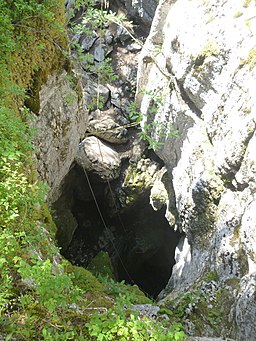Gouffre Berger
The Gouffre Berger is a French cave discovered on 24 May 1953 by Joseph Berger, Bouvet, Ruiz de Arcaute and Marc Jouffray. From 1953 to 1963, it was regarded as the deepest cave in the world at −1,122 metres (−3,681 ft), relinquishing this title to the previous contender, Pierre Saint Martin, in 1964, after further exploration. The Gouffre Berger is now ranked 28th deepest cave in the world, and the 4th in France.
| Gouffre Berger | |
|---|---|
 | |
| Location | Vercors |
| Coordinates | Lambert III : x=856.630; y=3329,440; z=1460 |
| Depth | 1271 m |
| Discovery | 1953 |
| Geology | Limestone |
| Entrances | 11 |
To return from the bottom of the cave back to the surface can take between 15 and 30 hours, without long breaks.
In 1967, Ken Pearce, a metallurgy lecturer from Britain, descended with the Pegasus Caving Club team from Nottingham UK, organised and led by Peter Watkinson, and along with a 40-metre (130 ft) dive, reached a depth of −1,133 metres (−3,717 ft). They emerged after 13 days underground, having set a new world record at the time.[1] In 1968, B Leger and J Dubois reached a depth of −1,141 metres (−3,743 ft). This record was held until July 1982, when Patrick Penez attained −1,191 metres (−3,907 ft). In 1990, a breakthrough was made, connecting the cave to the existing system, "Scialet de la Fromagère". This gives the current recorded depth as −1,271 metres (−4,170 ft). In June 2011 the terminal sumps were dived[2] and in 2014 another attempt was made to pass the sumps.[3]
In recent years there have been six fatalities in this cave, five due to water. During a storm or heavy rain, the Gouffre Berger can become a dangerous trap and the water levels rise very quickly. In 1996, Englishwoman Nicola Perrin (née Dollimore) and Hungarian Istvan Torda died due to violent flooding in the cave.[4]
The water that flows through the cave has been traced to re-appear in the flooded sections of the Cuves de Sassenage.[5] As of 2017 the system was estimated to contain approximately thirty-seven kilometres of passage with eleven entrances.[6]
Since 2013, clean-up actions have been carried out by cavers.[7] At the end of 2018 the gouffre Berger has become clean again.[8]
Location
The entrance is within the commune of Engins high on the Vercors Plateau.[9] In June 2001, the commune lifted a two-year ban on exploration.
- Co-ordinates: Lambert III : x=856.630; y=3329,440; z=1460[10]
Image gallery
- Aspects of the network
 karst near the gouffre Berger.
karst near the gouffre Berger. Entrance of "la Laitière Mutante".
Entrance of "la Laitière Mutante". "Puits des Rhododendrons", second highest entrance.
"Puits des Rhododendrons", second highest entrance. The "puits Marry" is the first cavity to reach the gouffre Berger.
The "puits Marry" is the first cavity to reach the gouffre Berger. The "gouffre de la Fromagère", the highest entrance.
The "gouffre de la Fromagère", the highest entrance..jpg) "Puits du Cheval Vapeur", upstream of the river without stars.
"Puits du Cheval Vapeur", upstream of the river without stars. "Gouffre des Elfes" connected to the gallery Petzl.
"Gouffre des Elfes" connected to the gallery Petzl. View of the cliffs of Sornin, in the background "l'oeil du Lapin" and the Grenoble bowl.
View of the cliffs of Sornin, in the background "l'oeil du Lapin" and the Grenoble bowl. Méander in the "gouffre des Elfes".
Méander in the "gouffre des Elfes". Stalagmitic Pillar.
Stalagmitic Pillar. Progress in the mud gallery.
Progress in the mud gallery.
 Pit Félix Ruiz de Arcaute, first pit of gouffre Berger.
Pit Félix Ruiz de Arcaute, first pit of gouffre Berger. Concrete meander.
Concrete meander. Pit with vertical grooves.
Pit with vertical grooves. Review of a rimstone in the network "Biboc".
Review of a rimstone in the network "Biboc". Le "gouffre Delta 35" is the last network-connected entry of gouffre Berger.
Le "gouffre Delta 35" is the last network-connected entry of gouffre Berger. Underground gallery.
Underground gallery. Le gouffre Berger is a "classic" in the caving community.
Le gouffre Berger is a "classic" in the caving community. Le "scialet du Cairn" falls back into le gouffre Berger.
Le "scialet du Cairn" falls back into le gouffre Berger. Detailed view of rimstone.
Detailed view of rimstone.
See also
References
- Pearce, Ken. "Gouffre Berger-l'expédition britannique 1964". site de plongées souterraines..
- Bianzani, David. "The exploration of the Terminal siphons of the Berger report 30 june 2011" (PDF). site of underground dives..
- Bianzani, David. "Causette. Explorations". site of underground dives..
- Profundezas. "In Memoriam"..
- "Les Cuves de Sassenage" (pdf). parc-du-vercors.fr..
- Map of gouffre Berger cave at comité départemental de spéléologie 39.fr.
- « Berger -1122, venez illuminer la rivière sans étoiles ».
- « Berger 2018: last but not least... ».
- "The entrances of gouffre Berger". geoportail.gouv.fr..
- Spéléo dans le Vercors Tome I - Edisud
Bibliography
- Opération -1000 by Jean Cadoux, Jean Lavigne, Géo Mathhieu, Louis Potié. - Grenoble : Edition de Grenoble, 1955.
- Réédition : Opération -1000, idem. - Marseille : Édition Jeann Lafitte. 261 pages ; ISBN 9782862762326
- Gouffre Berger premier -1000. 1956-2016 by Serge Caillault. - Corenc, édition Spéléo Magazine 94. 36 pages ; 2016; ISSN 1629-1573
- Gouffre Berger, l'esprit d'équipe by Mark Wright, Robbie Shone and others.- Sheffield: published by Vertebrate Publishing, 2014. 254 pages ; ISBN 9781910240120
- Histoire d’une équipe 1941-1956 : Gouffre Berger. Premier -1 000 [a team's history 1941-1956 by Founders du SGCAF] (in French). Albertville. 2015. p. 293. ISBN 978-2-9554-8940-6..
External links
- Access details, history and survey of cave
- Gouffre Berger at Troglophil.de
- Caving in the Gouffre Berger – « Immersion » - In the footsteps of Fernand Petzl
- Recommendations for descending the Gouffre Berger.